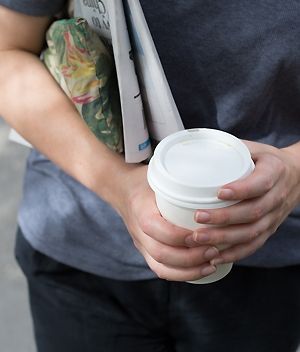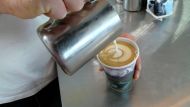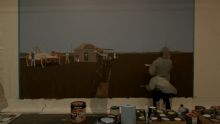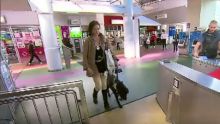Desperate for a coffee on holidays, I paid $4.75 for a standard long black at a McDonald's McCafe in Queensland.
The assistant poured an average brew. Too much water diluted the taste and the barista (that's being generous) would have struggled to make instant coffee. Yet I and several other customers paid up for a coffee that cost more than some burgers.
More WA News Videos
What's the real cost of a cup of coffee?
A Perth cafe owner explains what really goes in to every cup of coffee.
It was a similar story across town: coffees ranging from $4.50 to $4.90. Perhaps prices were inflated for school holidays or coffees were dearer in a regional town. A local told me coffee prices are always this high and nobody complains.
Back in Melbourne, the coffee was cheaper, better quality and expertly poured (for the most part). Still, a local cafe has increased its price by 20¢ a cup and others are doing the same. "Weekend penalty rates are killing us," the owner told me. Yeah, right.

Don't get me wrong: I love a good coffee as much as the next person. A single-origin coffee, poured by an expert barista, is worth every cent. It's cheap for those who read the cafe's free newspapers, use its Wi-Fi and linger, treating it as a meeting place or second office.
And before coffee suppliers and cafes hound me, I know there is more cost to a takeaway coffee than is obvious. Labour and store overheads are significant but I know of few consumer products that deliver the same fat margins as coffee. Some economists estimate the average takeaway costs 35¢ to produce.
How high can coffee prices go before there is a consumer backlash and why hasn't there been more disruption in the takeaway coffee market?
Also, can someone explain why Australians pay so much for coffee? Apart from the fact that the market allows it because so many people are addicted to their caffeine hit.

Coffee is huge business. Australians spend $1.1 billion a year on coffee and tea, according to the Australian Securities and Investments Commission's MoneySmart site. Australians who order a medium takeaway coffee each day spend $1522 a year on their habit, found 2016 research from Skip (a food and drink ordering App).
Queensland's coffee prices were consistently dearer than those in Victoria and New South Wales, said Skip. A medium coffee in Victoria averaged $4.10.

A cafe owner in Sydney told me his business sold enough coffee on Saturday (the queue was several lines deep) to pay the week's rent. Pouring hundreds of Italian coffees each day (worth every cent) was the difference between an average and exceptional business.
Coffee has unusual economics. For starters, cafe coffee prices seem to have little correlation with their commodity: coffee beans. Apparently, there has been record production of Arabica coffee, the higher-quality bean, thanks to bumper crops in South America. In other commodity markets, that would be mean lower prices.
How high can coffee prices go before there is a consumer backlash and why hasn't there been more disruption in the takeaway coffee market?
Second, consumers often favour higher-priced coffee because of quality perceptions. We pay $4 for a barista-style coffee yet shun a $1 automated coffee dispenser from a convenience store or petrol station, thinking it must taste like tar (it often does).
Some consumers are price sensitive to cafe food yet give little thought to coffee prices. I bet many reading this column do not know what they pay for coffee each day or how much of their income is spent on it each year.
We pay only slightly less, and often the same, for a takeaway compared to a cup in-store even though that has significantly higher costs. Food and drink ordering technology, which improves production efficiencies, has had little effect on prices
In theory, takeaway coffee prices should be falling as supply expands. You know it's a boom market when your local hairdresser sells takeaway coffees and every second food outlet has a coffee machine. Yet coffee prices only ever seem to rise.
Then there's the coffee "experience". As more consumers demand their caffeine hit, coffee at many cafes is taking longer to make. It's not unusual to wait 10 minutes for a takeaway at my local cafe on a busy Saturday morning.
Also, more coffee is being made by baristas with little training. Thank heavens for cafe hipsters who obsess about beans and how their coffee is poured. Too many cafes charge hipster coffee prices and pay novices to make it.
My hunch is takeaway coffee prices will rise over the next 18 months. As retail sales slow in a sluggish economy, coffee is an easier price hike. Rising competition in food outlets, particularly in shopping centres, will also cause more cafes to lift coffee prices.
I wonder how far this trend can go before there is a consumer backlash and more people substitute takeaway coffees with pod-style coffee at home. Or give the $1 coffees at convenience stores more of a go.
It's hard to see coffee breaking $5 – a price point that no longer requires loose change – and encourages consumers to compare coffee with food items. But who knows as people become hooked on cafe coffee and willingly pay higher prices?
Few products have more compelling economics than those that rely on addictions.















95 comments
New User? Sign up